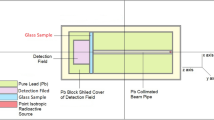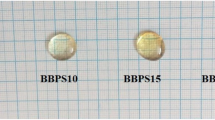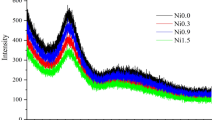Abstract
Sodium fluoroborate glasses with the mixed transition metal oxides (Bi2O3 and ZrO2) [65B2O3–25NaF–(10-x)Bi2O3–xZrO2, 0 ≤ x ≤ 6 mol percent] have been fabricated. According to xZrO2 values, the obtained glasses were named as BBNZ0, BBNZ2, BBNZ4, BBNZ5, and BBNZ6 glasses, respectively. The direct influence of (Bi2O3 and ZrO2) on physical, FTIR, optical, and gamma-ray shielding of the BBNZ-glasses has been investigated. The density of the fabricated glasses decreases linearly with about 18% as Bi2O3 is replaced by ZrO2. The number of N4 for BBNZ0 glass sample is about 0.47, which indicate that B2O3 is modified by NaF and Bi2O3 and the replacement of Bi2O3 by ZrO2 results in a slight decrease in the N4 value. Values of the direct optical bandgap were varied from 3.012 to 3.198 eV, while the indirect bandgap was varied from 2.665 to 2.913 eV for BBNZ0-BBNZ6 glasses. The refractive index of the investigated glasses is high, therefore can be applied in several optical applications. The linear (mass) attenuation coefficients LAC (MAC) varied from 0.11–169.81 (0.032–48.447), 0.10–139.81 (0.031–42.238), 0.09–109.765 (0.029–35.069), 0.09–94.09 (0.028–31.051), to 0.08–76.89 cm−1 (0.027–26.697 cm2/g) for BBNZ0-BBNZ6, respectively. As expected the trend in half value layer (HVL) value at each energy is (HVL)BBNZ0 < (HVL)BBNZ2 < (HVL)BBNZ4 < (HVL)BBNZ5 < (HVL)BBNZ6. The total stopping power (TSP) of the particles follow the order of increasing Bi2O3 content thus BBNZ0 has the highest TSP while BBNZ6 has the least. The present BBNZ-glasses are capable of functioning as thermal neutron and gamma-ray absorbers.














Similar content being viewed by others
References
D. Umamaheswari, B. Jamalaiah, T. Sasikala, T. Chengaiah, I.-G. Kim, L.R. Moorthy, Photoluminescence and decay behavior of Tb3+ ions in sodium fluoro-borate glasses for display devices. J. Lumin. 132, 1166–1170 (2012)
C.M. Reddy, G. Dillip, B.D.P. Raju, Spectroscopic and photoluminescence characteristics of Dy3+ ions in lead containing sodium fluoroborate glasses for laser materials. J. Phys. Chem. Solids 72, 1436–1441 (2011)
G. Lakshminarayana, A. Meza-Rocha, O. Soriano-Romero, E. Huerta, U. Caldiño, A. Lira, D.-E. Lee, J. Yoon, T. Park, Pr3+-doped B2O3-Bi2O3-ZnO-NaF glasses comprising alkali/mixed alkali oxides for potential warm white light generation, blue laser, and E-+ S-+ C-optical bands amplification applications. J. Mater. Res. Technol. (2021). https://doi.org/10.1016/j.jmrt.2021.06.037
A. Abd El-Rehim, K.S. Shaaban, Influence of La2O3 content on the structural, mechanical, and radiation-shielding properties of sodium fluoro lead barium borate glasses. J. Mater. Sci. 32, 4651–4671 (2021)
M. Mariyappan, S. Arunkumar, K. Marimuthu, Effect of Bi2O3 on JO parameters and spectroscopic properties of Er3+ incorporated sodiumfluoroborate glasses for amplifier applications. J. Non-Cryst. Solids 532, 119891 (2020)
M. Mariyappan, S. Arunkumar, K. Marimuthu, White light emission and spectroscopic properties of Dy3+ ions doped bismuth sodiumfluoroborate glasses for photonic applications. J. Alloy. Compd. 723, 100–114 (2017)
M.K. Murthy, K. Murthy, N. Veeraiah, Dielectric properties of NaF-B2O3 glasses doped with certain transition metal ions. Bull. Mater. Sci. 23, 285–293 (2000)
A. Pronkin, V. Naraev, I. Murin, I. Sokolov, Concentration dependence of electric conductivity for fluorine-containing sodium borate glasses. Glass Phys. Chem 26, 268–273 (2000)
H. Doweidar, K. El-Egili, R. Ramadan, E. Khalil, Structural species in mixed-fluoride PbF2–CdF2–B2O3 borate glasses FTIR investigation. Vib. Spectrosc. 102, 24–30 (2019)
E. Kamitsos, M. Karakassides, A spectroscopic study of fluoride containing sodium borate glasses. Solid State Ionics 28, 783–787 (1988)
I. Sokolov, V. Naraev, A. Nosakin, A. Pronkin, Influence of MeF2 (Me= Mg, Ca, Sr, and Ba) on the electrical properties of glasses in the MeF2-Na2B4O7 system. Glass Phys. Chem. 26, 383–389 (2000)
C. Jager, U. Haubenreisser, A reexamination of studies of the structure of NaF-Na2O-B2O3 glasses. Phys. Chem. Glasses 26, 152–156 (1985)
A. Balakrishna, S. Babu, V. Kumar, O. Ntwaeaborwa, Y. Ratnakaram, Optical properties and spectroscopic study of different modifier based Pr3+: LiFB glasses as optical amplifiers. Spectrochim. Acta Part A 170, 167–173 (2017)
R. Prasad, B.V. Siva, K. Neeraja, N.K. Mohan, J.I. Rojas, Effect of modifier oxides on spectroscopic and optical properties of Pr3+ doped PbO-Ro2O3–WO3–B2O3 glasses (with Ro2O= Sb2O3, Al2O3, and Bi2O3). J. Lumin. 230, 117666 (2021)
A.S. Abouhaswa, F.I. El-Agawany, E.M. Ahmed, Y.S. Rammah, Optical, magnetic characteristics, and nuclear radiation shielding capacity of newly synthesized barium boro-vanadate glasses: B2O3–BaF2–Na2O–V2O5. Radiat. Phys. Chem. 192, 109922 (2022). https://doi.org/10.1016/j.radphyschem.2021.109922
Y.S. Rammah, I.O. Olarinoye, F.I. El-Agawany, A. El-Adawy, El Sayed Yousef, The f-factor, neutron, gamma radiation and proton shielding competences of glasses with Pb or Pb/Bi heavy elements for nuclear protection applications. Ceram. Int. 46, 27163–27174 (2020). https://doi.org/10.1016/j.ceramint.2020.07.197
Y.S. Rammah, I.O. Olarinoye, F.I. El-Agawany, A. El-Adawy, A. Gamal, El Sayed Yousef, Elastic moduli, photon, neutron, and proton shielding parameters of tellurite bismo-vanadate (TeO2–V2O5–Bi2O3) semiconductor glasses. Ceram. Int. 46, 25440–25452 (2020). https://doi.org/10.1016/j.ceramint.2020.07.014
Y.S. Rammah, K.A. Mahmoud, E. Kavaz, F.I. Ashok Kumar, El-Agawany, The role of PbO/Bi2O3 insertion on the shielding characteristics of novel borate glasses. Ceram. Int. 46, 23357–23368 (2020). https://doi.org/10.1016/j.ceramint.2020.04.018
E. Hakan Akyildirim, F.I. Kavaz, E. El-Agawany, Y.S.R. Yousef, Radiation shielding features of zirconolite silicate glasses using XCOM and FLUKA simulation code. J. Non-Cryst. Solids 545, 120245 (2020)
A.M. Abd-Elnaiem, H.A. Saudi, H.M.H. Zakaly, S.A.M. Issa, M. Rashad, The effect of composition and γ-irradiation on the Vickers hardness, structural and optical properties of xLiNbO3-25CaO-35PbO-(40–x) waste systems. Ceram. Int. (2021). https://doi.org/10.1016/j.ceramint.2021.03.210
A.M.A. Henaish, M. Mostafa, B.I. Salem, H.M.H. Zakaly, S.A.M. Issa, I.A. Weinstein, O.M. Hemeda, Spectral, electrical, magnetic and radiation shielding studies of Mg-doped Ni–Cu–Zn nanoferrites. J. Mater. Sci. Mater. Electron. 31, 20210–20222 (2020). https://doi.org/10.1007/s10854-020-04541-x
S.A.M. Issa, M. Rashad, H.M.H. Zakaly, H.O. Tekin, A.S. Abouhaswa, Nb2O5- Li2O-Bi2O3-B2O3 novel glassy system: evaluation of optical, mechanical, and gamma shielding parameters. J. Mater. Sci. Mater. Electron. 31, 22039–22056 (2020). https://doi.org/10.1007/s10854-020-04707-7
A.M.A. Mostafa, S.A.M. Issa, H.M.H. Zakaly, M.H.M. Zaid, H.O. Tekin, K.A. Matori, H.A.A. Sidek, R. Elsaman, The influence of heavy elements on the ionizing radiation shielding efficiency and elastic properties of some tellurite glasses: theoretical investigation. Results Phys. 19, 103496 (2020). https://doi.org/10.1016/j.rinp.2020.103496
H.A. Saudi, H.O. Tekin, H.M.H. Zakaly, S.A.M. Issa, G. Susoy, M. Zhukovsky, The impact of samarium (III) oxide on structural, optical and radiation shielding properties of thallium-borate glasses: experimental and numerical investigation. Opt. Mater. (Amsterdam) 114, 110948 (2021). https://doi.org/10.1016/j.optmat.2021.110948
H.M. Zakaly, A. Ashry, A. El-Taher, A.G.E. Abbady, E.A. Allam, R.M. El-Sharkawy, M.E. Mahmoud, Role of novel ternary nanocomposites polypropylene in nuclear radiation attenuation properties: in-depth simulation study. Radiat. Phys. Chem. 188, 109667 (2021). https://doi.org/10.1016/j.radphyschem.2021.109667
G. Kilic, E. Ilik, S.A.M. Issa, B. Issa, U.G. Issever, H.M.H. Zakaly, H.O. Tekin, Fabrication, structural, optical, physical and radiation shielding characterization of indium (III) oxide reinforced 85TeO2-(15–x)ZnO-xIn2O3 glass system. Ceram. Int. 47, 27305–27315 (2021). https://doi.org/10.1016/j.ceramint.2021.06.152
H.M.H. Zakaly, H.A. Saudi, H.O. Tekin, M. Rashad, S.A.M. Issa, Y.S. Rammah, A.I. Elazaka, M.M. Hessien, A. Ene, Glass fabrication using ceramic and porcelain recycled waste and lithium niobate: physical, structural, optical and nuclear radiation attenuation properties. J. Mater. Res. Technol. 15, 4074–4085 (2021). https://doi.org/10.1016/j.jmrt.2021.09.138
D. Möncke, E.I. Kamitsos, A. Herrmann, D. Ehrt, M. Friedrich, Bonding and ion–ion interactions of Mn2+ ions in fluoride-phosphate and boro-silicate glasses probed by EPR and fluorescence spectroscopy. J. Non-Cryst. Solids 357, 2542–2551 (2011)
J. Holubová, Z. Černošek, E. Černošková, L. Beneš, Thermal properties and structure of zinc–manganese metaphosphate glasses. J. Therm. Anal. Calorim. 122, 47–53 (2015)
L.E. Alarcon, A. Arrieta, E. Camps, S. Muhl, S. Rudil, E.V. Santiago, An alternative procedure for the determination of the optical band gap and thickness of amorphous carbon nitride thin films. Appl. Surf. Sci. 254, 412–415 (2007)
D. Souri, Z.E. Tahan, A new method for the determination of optical band gap and the nature of optical transitions in semiconductors. Appl. Phys. B 119, 273–279 (2015)
Y.S. Rammah, H.O. Tekin, C. Sriwunkum, I. Olarinoye, A. Alalawi, M.S. Al-Buriahi, T. Nutaro, B.T. Tonguc, Investigations on borate glasses within SBC-Bx system for gamma-ray shielding applications. Nucl. Eng. Technol. 53(1), 282–293 (2021)
H.O. Tekin, S.A.M. Issa, E.M. Ahmed, Y.S. Rammah, Lithium-fluoro borotellurite glasses: nonlinear optical, mechanical, characteristics and gamma radiation protection characteristics. Radiat. Phys. Chem. 190, 109819 (2022). https://doi.org/10.1016/j.radphyschem.2021.109819
E. Şakar, Ö.F. Özpolat, B. Alım, M.I. Sayyed, M. Kurudirek, Phy-X/PSD: development of a user friendly online software for calculation of parameters relevant to radiation shielding and dosimetry. Radiat. Phys. Chem. 166, 108496 (2020)
A.M. El-Khayatt, H.R. Vega-Carrillo, Photon and neutron kerma coefficients for polymer gel dosimeters. Nucl. Instrum. Methods Phys. Res. Sect. A 792, 6–10 (2015). https://doi.org/10.1016/j.nima.2015.04.033
H. Baltas, Evaluation of gamma attenuation parameters and kerma coefficients of YBaCuO and BiPbSrCaCuO superconductors using EGS4 code. Radiat. Phys. Chem. 166, 108517 (2020). https://doi.org/10.1016/j.radphyschem.2019.108517
J.H. Hubbell, S.M. Seltzer, NIST Standard Reference Database 126. Tables of X-ray mass attenuation coefficients and mass energy-absorption coefficients from 1keV to 20MeV for elements Z= 1 to 92 and 48 additional substances of dosimetric interest [Internet]. Gaithersburg: National Institute of Standards and Technology; 1996 [cited 2019 Sep 11] (2004)
I.O. Olarinoye, R.I. Odiaga, S. Paul, EXABCal: A program for calculating photon exposure and energy absorption buildup factors. Heliyon 5(7), e02017 (2019). https://doi.org/10.1016/j.heliyon.2019.e02017
I.O. Olarinoye, Photon buildup factors for some tissues and phantom materials for penetration depths up to 100 MFP. J. Nucl. Res. Dev. 13, 57–67 (2017)
I.I. Bashter, Calculation of radiation attenuation coefficients for shielding concretes. Ann. Nucl. Energy 24(17), 1389–1401 (1997)
I.O. Olarinoye, F.I. El-Agawany, A. El-Adawy, Y.S. Rammah, Mechanical features, alpha particles, photon, proton, and neutron interaction parameters of TeO2–V2O3–MoO3 semiconductor glasses. Ceram. Int. 46(14), 23134–23144 (2020)
https://www.schott.com/en-in/products/radiation-shielding-glasses-p1000330 , n.d.
F.H. Attix, Introduction to radiological physics and radiation dosimetry (Wiley, Hoboken, 2008)
Y.S. Rammah, I.O. Olarinoye, F.I. El-Agawany, I. Akkurt, E. Yousef, Photon and neutron absorbing capacity of titanate-reinforced borate glasses: B2O3–Li2O–Al2O3–TiO2. J. Mater. Sci. 32(6), 7377–7390 (2021). https://doi.org/10.1007/s10854-021-05447-y
V.F. Sears, Neutron scattering lengths and cross sections. Neutron News 3(3), 26–37 (1992). https://doi.org/10.1080/10448639208218770
S.A. Issa, A.M. Ali, H.O. Tekin, Y.B. Saddeek, A. Al-Hajry, H. Algarni, G. Susoy, Enhancement of nuclear radiation shielding and mechanical properties of YBiBO3 glasses using La2O3. Nucl. Eng. Technol. 52(6), 1297–1303 (2020). https://doi.org/10.1016/j.net.2019.11.017
Acknowledgements
Taif University Researchers Supporting Project number (TURSP-2020/84), Taif University, Taif, Saudi Arabia.
Author information
Authors and Affiliations
Contributions
MHM, MSS, EMA, RAE, AMA, IOO, YSR: Conceptualization, Methodology, Software, Validation, Investigation, Data Curation, Writing—Review and Editing, Visualization, Supervision.
Corresponding author
Ethics declarations
Conflict of interest
The authors declare that they have no conflict of interest.
Consent for publication
Authors declare that this manuscript is original, has not been published before, and is not currently being considered for publication elsewhere.
Additional information
Publisher's Note
Springer Nature remains neutral with regard to jurisdictional claims in published maps and institutional affiliations.
Rights and permissions
About this article
Cite this article
Misbah, M.H., Shams, M.S., Ahmed, E.M. et al. Preparation, structural, optical characteristics, and photon/neutron attenuation competence of sodium fluoroborate glasses: Experimental and simulation investigation. J Mater Sci: Mater Electron 33, 16334–16347 (2022). https://doi.org/10.1007/s10854-022-08525-x
Received:
Accepted:
Published:
Issue Date:
DOI: https://doi.org/10.1007/s10854-022-08525-x




